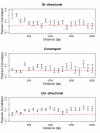Co-expression of neighbouring genes in Arabidopsis: separating chromatin effects from direct interactions
- PMID: 20233415
- PMCID: PMC2851598
- DOI: 10.1186/1471-2164-11-178
Co-expression of neighbouring genes in Arabidopsis: separating chromatin effects from direct interactions
Abstract
Background: In all eukaryotic species examined, genes that are chromosomal neighbours are more similar in their expression than random gene pairs. Currently, it is still unclear how much of this local co-expression is caused by direct transcriptional interactions, and how much is due to shared chromatin environments.
Results: We analysed neighbouring genes in Arabidopsis thaliana. At large intergenic distances (>400 bp), divergently and convergently transcribed gene pairs show very similar levels of co-expression, mediated most likely by shared chromatin environments. At gene distances below 400 bp, co-expression is strongly enhanced only for divergently transcribed gene pairs, indicating bi-directional transcription from a single promoter. Conversely, co-expression is suppressed for short convergently or uni-directionally transcribed pairs. This suppression points to transcriptional interference concentrated at the 3' end, e.g., in the context of transcription termination.
Conclusions: Classifying linked gene pairs by their orientation, we are able to partially tease apart the different levels of regional expression modulation. (i) Regional chromatin characteristics modulate the accessibility for regulation and transcription, regardless of gene orientation; the strength of this chromatin effect can be assessed from divergently or convergently transcribed distant neighbours. (ii) Shared promoter regions up to 400 bp in length enhance the co-expression of close bi-directional neighbours. (iii) Transcriptional interference of close neighbours is concentrated at the 3' ends of genes, and reduces co-expression on average by 40%.
Figures


Similar articles
-
Islands of co-expressed neighbouring genes in Arabidopsis thaliana suggest higher-order chromosome domains.Plant J. 2006 Feb;45(3):347-57. doi: 10.1111/j.1365-313X.2005.02619.x. Plant J. 2006. PMID: 16412082
-
Coexpression of neighboring genes in the genome of Arabidopsis thaliana.Genome Res. 2004 Jun;14(6):1060-7. doi: 10.1101/gr.2131104. Genome Res. 2004. PMID: 15173112 Free PMC article.
-
Assessing the influence of adjacent gene orientation on the evolution of gene upstream regions in Arabidopsis thaliana.Genetics. 2010 Jun;185(2):695-701. doi: 10.1534/genetics.110.114629. Epub 2010 Mar 16. Genetics. 2010. PMID: 20233855 Free PMC article.
-
Overlapping expression patterns among the genes encoding Arabidopsis chromosomal high mobility group (HMG) proteins.FEBS Lett. 2007 Mar 20;581(6):1114-8. doi: 10.1016/j.febslet.2007.02.015. Epub 2007 Feb 15. FEBS Lett. 2007. PMID: 17316617
-
Spatiotemporal expression control correlates with intragenic scaffold matrix attachment regions (S/MARs) in Arabidopsis thaliana.PLoS Comput Biol. 2006 Mar;2(3):e21. doi: 10.1371/journal.pcbi.0020021. Epub 2006 Mar 31. PLoS Comput Biol. 2006. PMID: 16604187 Free PMC article. Review.
Cited by
-
Identification and functional characterization of bidirectional gene pairs and their intergenic regions in cotton.BMC Plant Biol. 2024 Sep 4;24(1):829. doi: 10.1186/s12870-024-05548-w. BMC Plant Biol. 2024. PMID: 39232709 Free PMC article.
-
Promoter-pervasive transcription causes RNA polymerase II pausing to boost DOG1 expression in response to salt.EMBO J. 2023 Mar 1;42(5):e112443. doi: 10.15252/embj.2022112443. Epub 2023 Jan 27. EMBO J. 2023. PMID: 36705062 Free PMC article.
-
A comparative gene analysis with rice identified orthologous group II HKT genes and their association with Na(+) concentration in bread wheat.BMC Plant Biol. 2016 Jan 19;16:21. doi: 10.1186/s12870-016-0714-7. BMC Plant Biol. 2016. PMID: 26786911 Free PMC article.
-
Gene expression: sizing it all up.Front Genet. 2011 Oct 17;2:70. doi: 10.3389/fgene.2011.00070. eCollection 2011. Front Genet. 2011. PMID: 22303365 Free PMC article.
-
Physical mapping of immune-related genes in Yesso scallop (Patinopecten yessoensis) using fluorescent in situ hybridization.Comp Cytogenet. 2016 Oct 25;10(4):529-541. doi: 10.3897/CompCytogen.v10i4.10047. eCollection 2016. Comp Cytogenet. 2016. PMID: 28123676 Free PMC article.
References
MeSH terms
Substances
LinkOut - more resources
Full Text Sources

